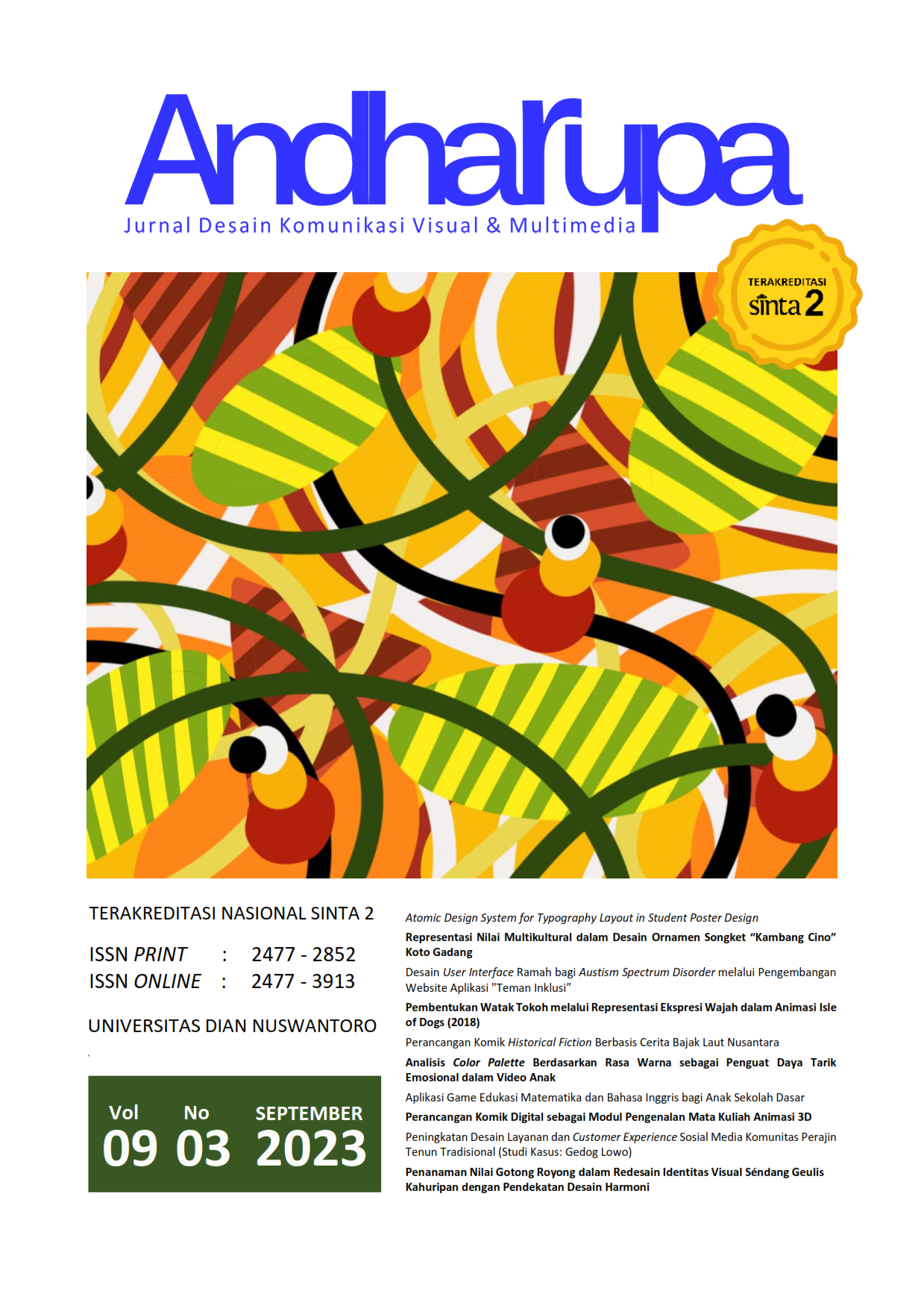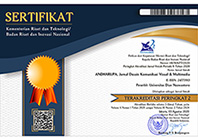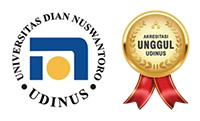Atomic Design System for Typography Layout in Student Poster Design
DOI:
https://doi.org/10.33633/andharupa.v9i03.7634Abstract
AbstrakPenelitian ini bertujuan untuk menerapkan atomic design system pada proses perancangan desain poster komunikasi visual. Banyak cara menciptakan produk desain untuk kebutuhan tertentu. Urgensi penelitian ini adalah karena selama ini banyak desainer terutama mahasiswa, yang bingung dengan proses desain poster. Banyak metode desain yang tidak semuanya sesuai dengan penciptaan desain poster. Maka, atomic design ayatem merupakan alternatif metode yang dapat digunakan untuk membuat desain poster. Desain poster tersebut memiliki dua tujuan yang penting, yaitu menyampaikan pesan atau informasi dengan baik dan benar pada masyarakat, dan menampilkan informasi tersebut dengan artistik dan estetik. Atomic Design System dapat membantu desainer dalam membuat desain dengan tujuan-tujuan tersebut. Disamping langkah yang sistematis, system ini juga membuat elemen desain dan elemen informasi yang akan disajikan teridentifikasi dengan lengkap. Metode atomic memiliki langkah-langkah sebagai berikut: atomic element, molekul element, organisme desain, menyiapkan halaman, serta merancang template desain . proses dari atomic design system ini menghasilkan elemen desain yang tertata, alur baca yang baik, serta template design yang dapat diterapkan pada desain lain. Studi kasus perancangan poster PIMNAS merupakan studi yang tepat karena poster PIMNAS menampilkan banyak informasi dan data serta harus disajikan dengan runtut dan jelas. Hasil dari penerapan Atomic Design System adalah final design poster PIMNAS dengan legibility dan readability yang baik. Kata Kunci: atomic design, desain poster, sistem tata letak, tipografi AbstractThis study aims to apply the atomic design system to the poster design process of visual communication design. There are many ways to create and design products for specific needs. This research is urgent because many designers, especially students, are confused about the poster design process. Many design methods are not all appropriate for creating poster designs. So, the atomic design system is an alternative method that can be used to make poster designs. These poster designs have two important goals: conveying messages or information properly and correctly to the public and presenting the information artistically and aesthetically. Atomic Design System can assist designers in making designs with these goals. In addition to systematic steps, this system also makes design elements and information elements be presented wholly identified. The atomic method has the following steps: Atomic elements, Molecular elements, design organisms, prepare pages, and design templates. This atomic design system produces well-organized design elements, good reading flow, and design templates that can be applied to other designs. The PIMNAS poster design case study is the proper study because the PIMNAS poster displays a lot of information and data and must be presented coherently and clearly. The result of implementing the Atomic Design System is the final PIMNAS poster design with good legibility and readability. Keywords: atomic design, layout system, poster design, typographyReferences
Ardhianto, P. (2016). Tinjauan Desain pada Karya Poster; Studi Kasus Seri Poster “Marlyn Fish 2009.” ANDHARUPA: Jurnal Desain Komunikasi Visual & Multimedia, 2(01), Article 01.
Arifrahara, G. (2021). Analisis Penggunaan Tipografi Spasial Sans Serif Dalam Ruang Publik Taman Tematik Kota Bandung. ANDHARUPA: Jurnal Desain Komunikasi Visual & Multimedia, 7(01), Article 01.
Badarch, B. (2021). Inhound: The Table of Content Bilateral Design. Pinterest. https://id.pinterest.com/pin/Ab8eZS2ToB2xFL47Vi2_v6SW5fQPEiV38_2Cuajg64GHTA53aEOlMNE/
Carter, M. (2021). 4—Typography. In M. Carter (Ed.), Designing Science Presentations (Second Edition) (pp. 43–55). Academic Press. https://doi.org/10.1016/B978-0-12-815377-2.00004-4
Cheng, K. (2020). Designing Type (2nd ed.). Yale University Press.
Czarnecki, L. (2018). 7 Essential Typographic Layout Systems. Type365.
Erlyana, Y., & Ressiani, R. (2020). Perancangan Buku Desain Kemasan ”Basic Of Packaging”. ANDHARUPA: Jurnal Desain Komunikasi Visual & Multimedia, 6(02), Article 02.
Frascara, J. (2022). Revisiting "Graphic Design: Fine Art or Social Science?"—The Question of Quality in Communication Design. She Ji: The Journal of Design, Economics, and Innovation, 8(2), 270–288.
Frost, B. (2016). Atomic Design. Brad Frost Publisher.
Hébel, F., & Fleetwood, J. (2013). Transition, Paysages d’une Société. Xavier Barral. https://www.decitre.fr/livres/transition-paysages-d-une-societe-9782365110297.html
Hermanto, Y. A. L. (2021, December 14). Creative Process in Creating Letters Design. International Seminar on Language, Education, and Culture (ISoLEC 2021), Malang, Indonesia.
Hermanto, Y. A. L., Pahlevi, A. S., & Sutrisno, A. A. (2019). Identifikasi Ilustrasi-Tipografi Graphic Vernacular Sebagai Sistem Tanda & Identitas Warung Tenda Di Kota Malang. JADECS, 3(2), 78–87.
Hermanto, Y. A. L., Pujiyanto, & Pahlevi, A. S. (2022). Lateral Thinking in Typography Layout System: (Alternative Layout Design for Effective Message Delivery). 4th International Conference on Innovation in Engineering and Vocational Education (ICIEVE 2021), Bandung, Indonesia.
Hu, H., Zhang, C., & Liang, Y. (2021). A study on the automatic generation of banner layouts. Computers & Electrical Engineering, 93, 107269.
Jack, N. (2008). A bunch of poems by Charles Bukowski. DeviantArt. https://www.deviantart.com/natejack/art/Finger-Print-Poems-90177274
Kikuchi, K., Otani, M., Yamaguchi, K., & Simo-Serra, E. (2021). Modeling Visual Containment for Web Page Layout Optimization. Computer Graphics Forum, 40(7), 33–44.
Li, Z. (2019). Application research of digital image technology in graphic Design. Journal of Visual Communication and Image Representation, 65, 102689.
MarketMe, S. (2018). Barni Startup. MarketMe France. https://www.market-me.fr/barni-startup/
Muller-Brockmann, J. (1961). Musica Viva—January 6, 1961—Muller-Brockmann, Josef, 1961. 35.4’’ x 50.4’’ / 90 x 128 cm. Silkscreen | Paper. ID# SWL14515. $950. International Poster. https://www.internationalposter.com/product/musica-viva--january-6-1961/
Phoenix, B. (2009). Just cool – Page 2. Oblivion. https://billyphenix.wordpress.com/category/just-cool/
Puhalla, D., & Cullen, K. (2018). Layout Workbook: Revised and Updated: A real-world guide to building pages in graphic Design (Revised, Updated edition). Rockport Publishers.
Putri, A. N. L. (2020, September 28). Ajang Paling Bergengsi, Apa itu PIMNAS dan PKM? Campuspedia News. https://campuspedia.id/news/apa-itu-pimnas-dan-pkm/
Rustan, S. (2008). Layout, Dasar & Penerapannya. Gramedia Pustaka Utama. https://opac.perpusnas.go.id/DetailOpac.aspx?id=335475
Samara, T. (2017). Making and Breaking the Grid, Second Edition, Updated and Expanded: A Graphic Design Layout Workshop (Updated, Expanded edition). Rockport Publishers.
Socio, D. S. (2014). KAE — Strategic Marketing. Behance. https://www.behance.net/gallery/14625565/KAE-Strategic-Marketing
Sukendra, I. K., & Atmaja, I. K. S. (2020). Instrumen Penelitian. Mahameru Press.
Tim Penyusun Pimnas. (2022). Panduan Pekan Ilmiah Mahasiswa Nasional ke-35 Tahun 2022. Balai Pengembangan Talenta Indonesia, Pusat Prestasi Nasional, Kementerian Pendidikan, Kebudayaan, Riset, Dan Teknologi.
Widyo. (2020, March 17). Program Kemahasiswaan Dikti: Mahasiswa Cerdas Komprehensif dan Kompetitif: Pekan Ilmiah Mahasiswa Nasional (PIMNAS). Program Kemahasiswaan Dikti. http://kemahasiswaandikti.blogspot.com/2015/11/pekan-ilmiah-mahasiswa-nasional-pimnas.html
Downloads
Published
Issue
Section
License
Authors who publish with this journal agree to the following terms:
- Authors retain copyright and grant the journal right of first publication with the work simultaneously licensed under a Creative Commons Attribution License that allows others to share the work with an acknowledgment of the work's authorship and initial publication in this journal.
- Authors are able to enter into separate, additional contractual arrangements for the non-exclusive distribution of the journal's published version of the work (e.g., post it to an institutional repository or publish it in a book), with an acknowledgment of its initial publication in this journal.
- Authors are permitted and encouraged to post their work online (e.g., in institutional repositories or on their website) prior to and during the submission process, as it can lead to productive exchanges, as well as earlier and greater citation of published work (See The Effect of Open Access).















